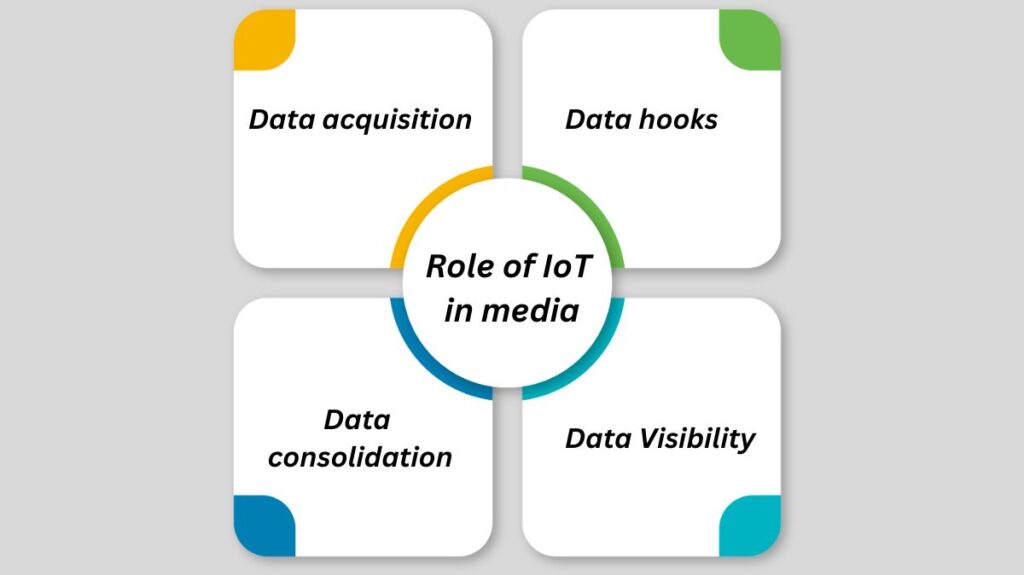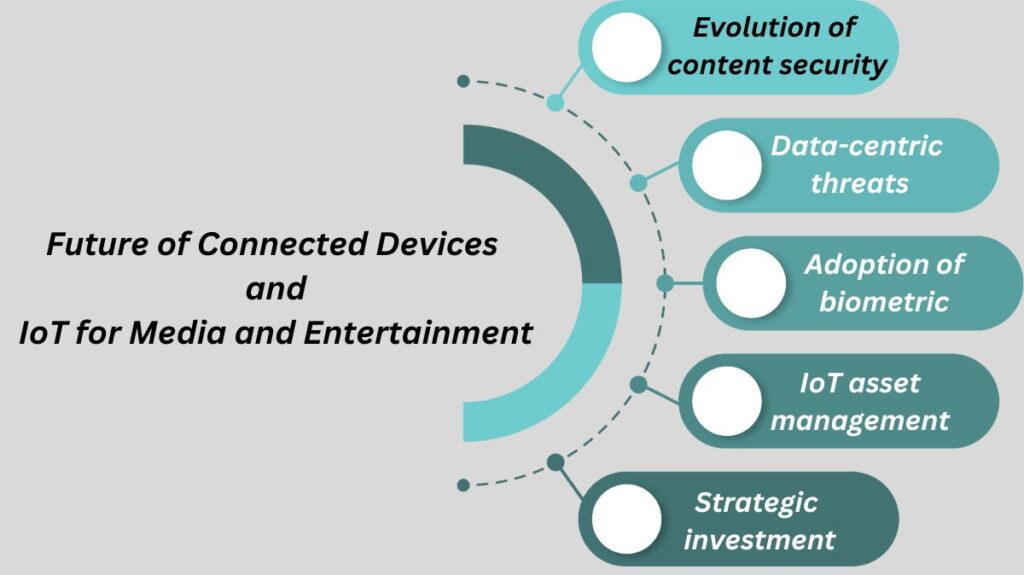IoT in Media and Entertainment
The rapidly growing IoT sector in media and entertainment, along with cloud platforms and big data analytics, enables the industry to attain unparalleled success by optimizing both human and machine resources.
With the help of connected smart devices and environmental sensors, the Internet of Things (IoT) builds a robust ecosystem that makes it simple to track assets across different locations. Asset management systems are vulnerable to human error, delays, and issues including poor reporting, poor maintenance, and underutilization in the absence of the Internet of Things.
Theft, underutilization of resources, a lack of data, and outdated client information all hinder success. By enabling tailored content consumption and predictive analytics, the Internet of Things’ rise is changing the landscape of IoT use cases for information media and entertainment. Welcome to the future of storytelling and the world where connectivity is fostering creativity.
IoT applications in media
As connected devices multiply quickly, the Internet of Things is transforming the media and entertainment industry and generating a wide range of new options. Customers have more options than ever before on what and when to eat. By giving content providers thorough insights into user preferences, this move is pushing IoT use cases for information, media, and entertainment.
Examples of how the Internet of Things is integrating with the industry’s architecture include immersive, tailored content and targeted advertising. Its impact also extends to efficient asset management, which is changing how the media sector approaches upcoming challenges. The Internet of Things is more than just a passing trend in the media and entertainment industry; it is a force for change that will affect how interact with and consume information going forward.
IoT’s role in media and entertainment

In the field of interactive media and entertainment, IoT bridges the gap between the digital and physical worlds. Each of the four integration layers increases the efficacy of asset management:
Data acquisition
In the Internet of Things, sensors meticulously detect and measure light, sound, temperature, humidity, pressure, biometrics, proximity, acceleration, speed, and GPS for media and entertainment data collection. Smart devices from wearables and smartphones to smart TVs, game consoles, and home automation devices respond to sensor inputs or collect data independently, creating this complicated system. This dynamic interaction lays the foundation for new IoT use cases for information media and entertainment, ushering in an era where advanced information gained from this symphony of data collecting will be used to create immersive and customized experiences.
Data consolidation
As the conductor of the orchestra in media and entertainment data aggregation, IoT harmonizes data from sensors and smart devices. Gateways are essential to the seamless transfer of this diverse data to large cloud platforms through increased bandwidth since they combine and store it. These gateways’ versatility and simplicity of use across a range of cellular, Bluetooth, and Wi-Fi protocols enhance connectivity. These gateways ensure the confidentiality and integrity of the complex data tapestry by offering robust device security levels in addition to data consolidation. All of these IoT use cases for media and entertainment have data consolidation at their core, which is transforming the sector to become more efficient and integrated.
Data hooks
In media and entertainment, the concept of “data hooks” is becoming the key to the Internet of Things. Because IoT platforms are skilled at collecting and managing data from gateways, devices, and other sources, they are essential in this scenario. These data are not just collected. They can be easily transferred to cloud-based applications, opening up a world of possibilities for information processing, analysis, and extraction. An ecosystem that supports IoT use cases for information and entertainment media is formed by the connection between cloud platforms and machine learning. Data orchestration is the foundation of a system that predicts user preferences and creates content that speaks on a very personal level.
Data Visibility
The Internet of Things in media and entertainment is becoming a more important part of the concept of data visibility. At this stage, processed data that is presented in an aesthetically pleasing and intelligible way takes center stage. This transparency allows industry stakeholders, including creators, distributors, and advertising, to understand about the future. In this networked ecosystem that encompasses all IoT use cases for information, media, and entertainment, data openness promotes a collaborative atmosphere where strategic decision-making is guided by actionable insights. To promote a shared vision for the future of the media and entertainment sectors, data is crucial, but so is making it visible.
Future of Connected Devices and IoT for Media and Entertainment

The evolution of content security
- Content security is crucial for the future of IoT in media and entertainment, particularly in a world full of data and gadgets, including ones that kids can use.
- To guarantee individualized, age-appropriate content and successfully handle privacy concerns, strong parental controls are required across platforms and devices.
Data-centric threats
- IoT devices like Amazon Echoes, security cameras, and refrigerators are data silos.
- It’s crucial to protect home IoT from hackers since these gadgets empower users but also compromise security and privacy.
Adoption of biometric security systems
- A slow transition to biometric security, which will replace less secure numerous passwords and improve security in the connected world.
The critical role of IoT asset management solutions
- The media and entertainment sector has countless opportunities with IoT asset management systems.
- They offer profound insights into end-user behavior and streamline asset maintenance as effective predictive monitoring solutions.
Strategic investment in intelligent IoT systems
- Media and entertainment organizations must make strategic investments in intelligent IoT systems as the number of IoT devices on the market continues to grow.
- They will be able to fully utilize IoT use cases for information media and entertainment and be at the forefront of technological advancement as a result.
In the age of linked gadgets and the Internet of Things, the media and entertainment sector will reach previously unheard-of heights with a planned narrative of innovation, security, and customized experiences.
Read more on IoT Applications: Revolutionizing Smart Technologies
Read more on IoT Applications in Smart Vehicles For Better Access, Safety
Read more on IoT Applications In Agriculture: Boosting Farm Productivity
Read more on Applications of IoT in Smart Home Expanding Safety & Quality
Read more on Top IoT applications In Healthcare For Better Efficiency
Read more on Applications Of IoT In Smart Cities For Better Living
Read more on IoT Applications in Retail: Smarter Stores & Supply Chains
Read more on Applications Of IoT In Education: Smart Schools & E-Learning
Read more on Applications Of IoT In Government: Security & Public Safety
Read more on What Is Consumer IoT And Consumer IoT Applications
Read more on Applications of IoT In Manufacturing And Key Benefits
Read more on The Role Of IoT In Energy: Use Cases And Key Challenges
